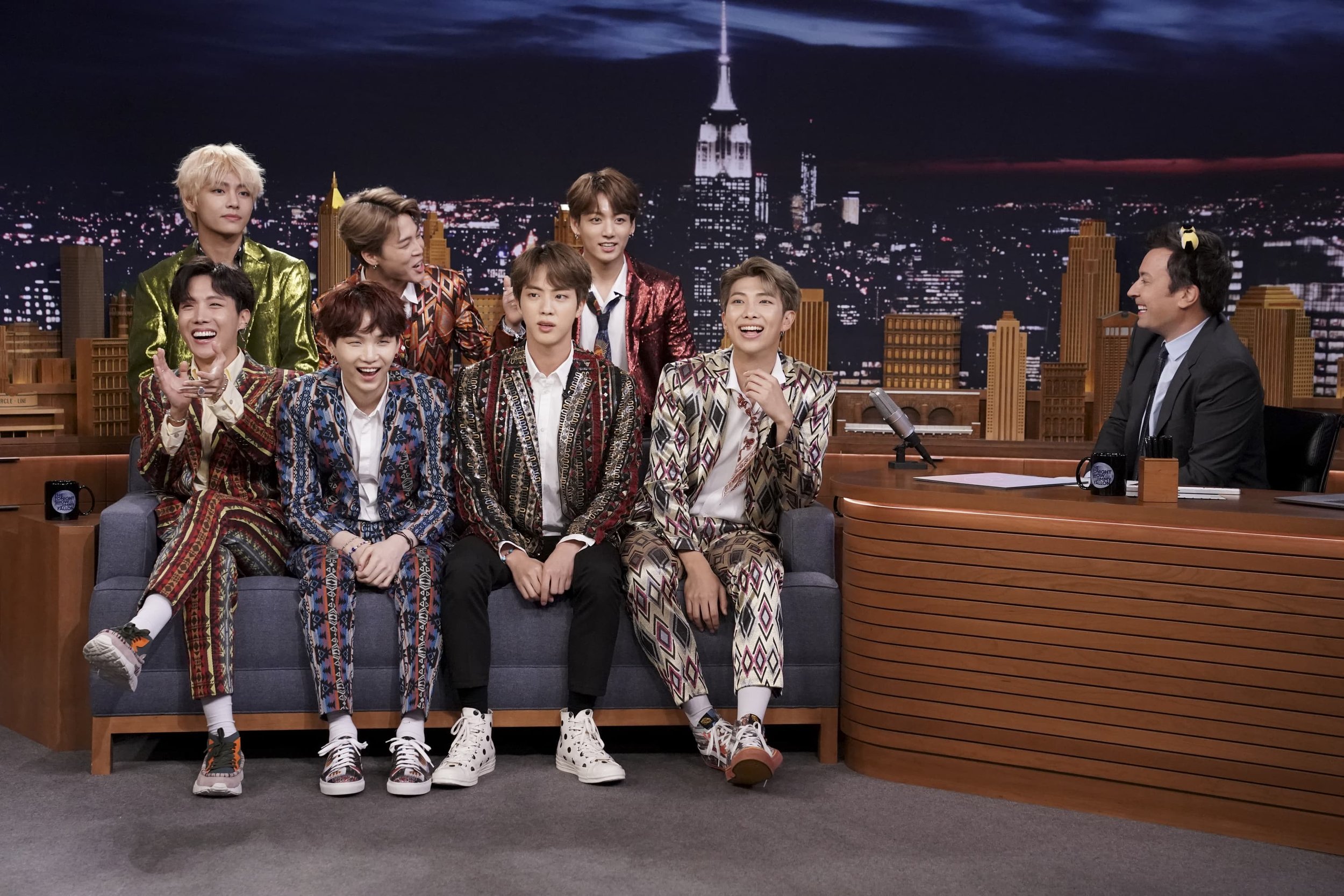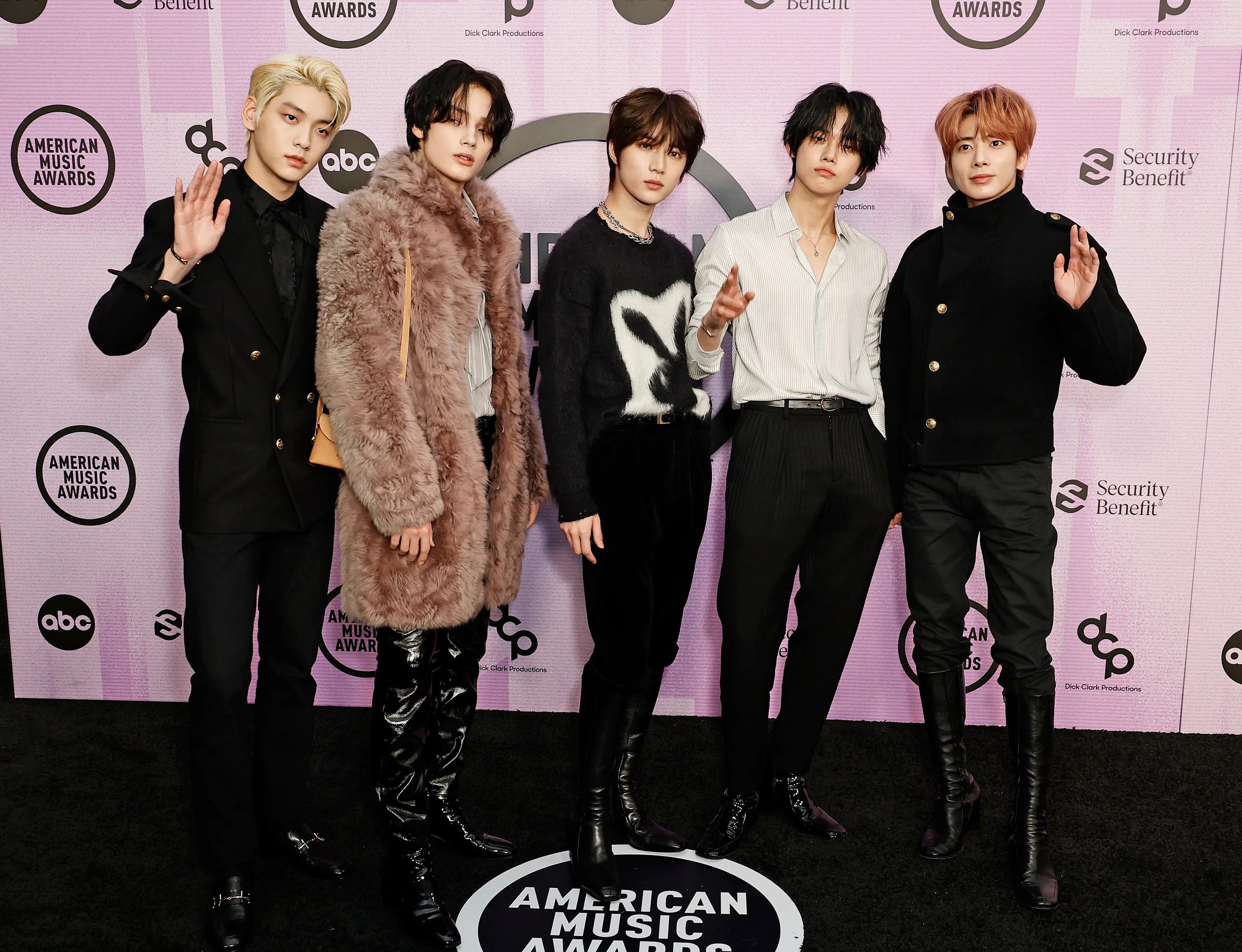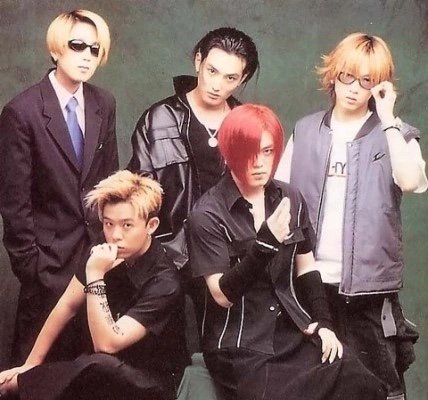A Global Phenomenon
BTS was invited as a guest on “The Tonight Show Starring Jimmy Fallon” on September 26, 2018. Photo credits - NBC/Getty Images
A global phenomenon is someone or something that occurs and impacts all parts of the world, and with music being popular internationally, being a global phenomenon has become a goal for many artists. Doing this, however, can be a difficult bridge to cross, but in South Korea that became possible through a genre called Korean pop, or K-Pop.
The “Korean Wave” spread around the world beginning with PSY’s “Gangnam Style” and the seven-member boy band BTS took over the music industry beginning in 2017 with outstanding success. While the obvious language barrier would seem to decrease their popularity, but BTS proved the contrary. BTS is presented as people to look up to by not only speaking on social issues and universal struggles through their music, but also how they publicly present themselves.
Tomorrow X Together attending the American Music Awards on November 20, 2022. Photo by Frazer Harrison
Ever since BTS gained a following in the US, other groups have followed in their footsteps. New generation groups like LESSERAFIM, Tomorrow by Together, New Jeans, and more have made their way into the American pop scene, whether it be at award shows, as models in new marketing campaigns, or even tours around the country.
There have even been strives to replicate K-Pop groups in the US. BTS’s label, HYBE, recently debuted a new group, Katseye, in a game show style similar to Korean networks, where fans could vote for their favorite members and help decide which six girls would take their place as a member in the group. As the integration of new trends in the music industry continues to escalate, a look into the past shows that BTS wasn’t the beginning of the Korean Wave.
In the 1960’s, the Korean War, which had taken place on the border, had just ended, and many American troops were sent to South Korea to aid in creating a democracy and protecting them from North Korea. (Seth) Rock and roll was incredibly popular in the United States and many American troops were looking for a show from the Korean artists while they were in South Korea. Any artist who performed for the American army saw it as a privilege. The Key Boys, the first rock and roll band in South Korea, took flight and was able to perform for the American army and were acclaimed.
South Korean President Park Chung-hee with President Jimmy Carter at a welcome ceremony in Seoul in 1979. Photo credit: Korea Times
South Korea fell into a dictatorship in 1961 when President Park Chung Hee came into power and caused the country to spiral into havoc politically and socially. He emphasized wanting to change how South Korea was seen culturally by creating laws that controlled what media was put out to the public, including music. (YouTube Originals)
Young people revolted against these new laws, but this caused the government to create even more regulations that took away their freedoms. The government disliked rock and roll and censored it from radios. Rock bands that defied the governments rule of not playing their music would be taken away by the police.
While the government was a major setback in creating the music that South Korea has today, about 30 years later came a wave of new types of music from America and Europe. Euro-disco was the craze, and night clubs opened up all around South Korea that invited both Korean and foreign guests. K-pop was now defined as “a Korean melody mixed with Western beats”, as K-pop was being created through Western genres like hip hop and R&B.
Seo Taiji and Boys performing. Photo by SeoTaiji Company
In 1993, a group called Seo Taiji and Boys debuted presenting the genre of Western hip hop with influences from Black music in America. They debuted on MBC’s talent show in 1992 and got a low score from the judges. The group was said to have focused more on the dancing than their music. (YouTube Originals) They danced in tight synchronization in the style of hip hop. While they didn’t receive high acclaim on the talent show, they rose to fame after that performance. They were one of the first K-pop stars to not only focus on the music, but also on their personal image physically and socially.
In 1996, a group called H.O.T. debuted, emulating the American pop group, New Kids on the Block. H.O.T.’s agency, SM Entertainment, used their trainees an opportunity to create a similar boy band to ones succeeding in other countries. (Masley) They picked five eighteen-year-old trainees that were good looking to grab the attention of fans. They were portrayed as glamourous and powerful with their well thought out wardrobe and intricate choreography.
H.O.T. Korean band from their album, “Outside Castle” (2001). Photo credits: SM Entertainment
The fans couldn’t get enough of H.O.T., and with the new revelation H.O.T. brought to the music industry, the agencies created the new name for girl and boy groups: idol groups. They were seen less as people and more as products. H.O.T. surprisingly was able to become a pop sensation in other countries besides South Korea, as it was not normal to become popular abroad in South Korea. SM Entertainment allowed their group to open up new windows into the global industry.
During the 2000’s, South Korea continued to expand the K-Pop industry abroad. JYP Entertainment, formed in 1997 by Korean artist Park Jin-Young, created a girl idol group called Wonder Girls that emulated 70’s and 80’s music with elements of synthetic pop. Park Jin-Young’s tactic was to modernize the past and give audiences a familiar sound to ease them into a new group. Wonder Girls were able to tour in the United States with The Jonas Brothers as their opening act. (YouTube Originals)
Wonder Girls performing at the Jonas Brothers World Tour in 2009. Photo credits: YouTube creator, n00dles413
Unfortunately, audiences did not enjoy their music, and while in Korea they would walk on stage with screaming fans, in the United States the crowd was silent. Their biggest downfall was caused by the language barrier, and other groups since then were able to learn the importance of having many languages under their idols’ belts.
In 2012, EDM, or electronic dance music, became incredibly popular in the United States. K-Pop ran with the idea and an artist named PSY debut his single Gangnam Style. PSY, the 34-year-old K-Pop artist, used the song to make fun of the accumulated wealth of South Korea, speaking about the wealthy Gangnam District. His music video became a YouTube sensation and traveled around the world.
PSY in his music video for “Gangnam Style”. Photo credit: YG Entertainment
According to “Gangnam Style’: How Psy’s K-Pop Satire Hit YouTube’s First 1bn Views”, “‘Gangnam Style’s international success can be put down to a variety of factors: a great video filled with a mix of silliness and satire; a supremely catchy tune; and a dance that was bizarre, brilliant, and easy to parody,” (Bowler). These three factors shaped the images of K-Pop today, and while many artists have strayed from the silly satire music and converted to more serious topics, PSY made it possible to go big with a song of such sarcasm.
Shortly after PSY’s impact in the US, BTS debuted in 2013 through the K-Pop label, Big Hit Entertainment, now known as HYBE. BTS had a foundation of rap and hip-hop and connected with their audience from the beginning about relatable struggles of young people in South Korea. They connected with their audience through a video streaming service called V-Live which proved to their fans that BTS cared for them and actively wanted to connect with them, which spread the fandom to other parts of East Asia. (Kim)
BTS performing at the American Music Awards in 2017. Photo credits: Just Jared
In 2014, BTS was showcased at KCON in Los Angeles, a celebration of Korean culture. Within two years, they became the main act, and in 2017, they performed their song, “DNA” at the American Music Awards. Their acclaim in the US skyrocketed from there and built a bridge for other groups like them to be recognized.








